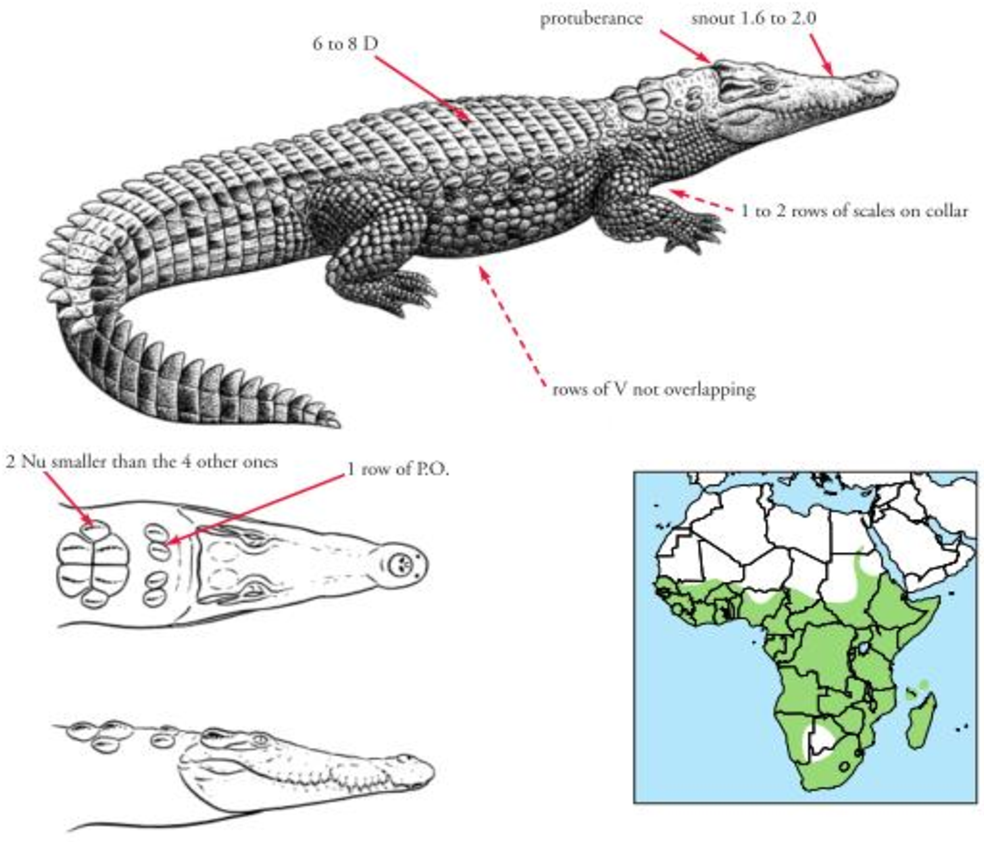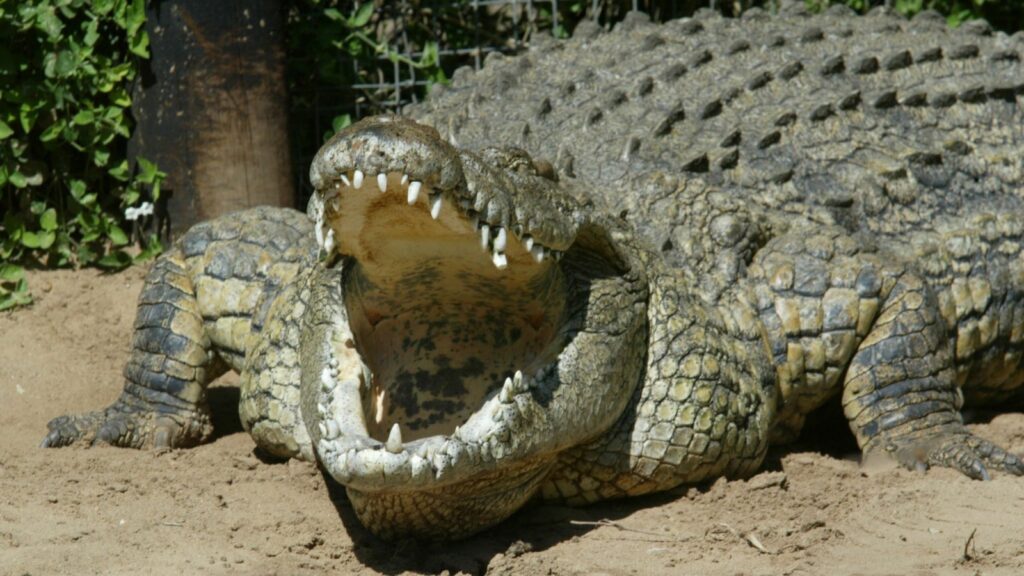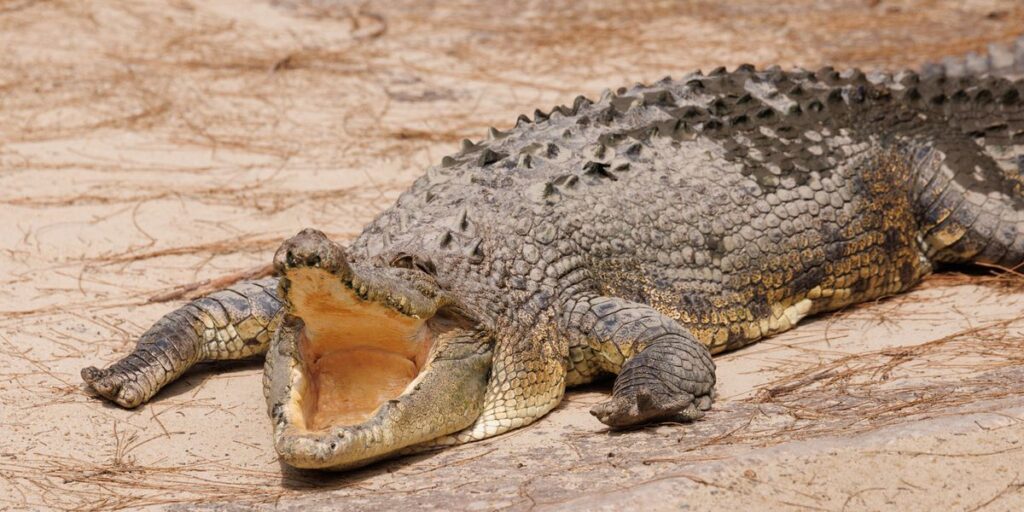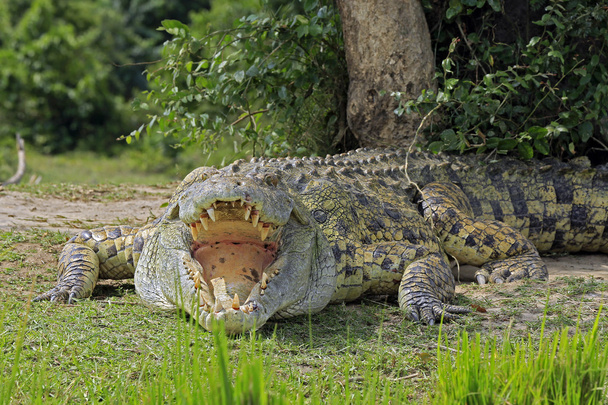Nile Crocodile Scales and Armor
Nile Crocodile Scales and Armor The Nile crocodile (Crocodylus niloticus) is one of the most iconic and formidable reptiles in the world. Found in various freshwater habitats across Africa, these ancient creatures have evolved remarkable adaptations that ensure their survival in the wild. Among these adaptations, their scales and armor play a crucial role, offering protection, facilitating thermoregulation, and enhancing their hunting prowess. This article explores the unique features of Nile crocodile scales and armor, shedding light on their significance in the animal’s life.
Anatomy of Nile Crocodile Scales

A. Description of the Scales
Nile crocodiles possess a tough, protective outer layer made up of bony scales, known as scots. These scales are composed of keratin, the same protein found in human nails and hair, and are reinforced with a layer of bone, providing a formidable barrier against threats.
B. Types of Scales
The scales of Nile crocodiles can be categorized into three main types:
- Dorsal Scales: Located on the back, these scales are particularly large and rugged, providing excellent protection against predators and rivals. Their unique arrangement allows for flexibility while maintaining strength.
- Ventral Scales: Found on the belly, these scales are softer and flatter than their dorsal counterparts. While they offer some protection, their primary role is to aid in movement and swimming.
- Tail Scales: The tail is covered in robust, overlapping scales that contribute to the crocodile’s powerful swimming ability and defense mechanisms. The tail scales also contain osteoderms, enhancing their protective function.
C. Coloration and Patterns
The scales of Nile crocodiles typically exhibit a combination of dark green, brown, and gray hues, allowing them to blend seamlessly into their environment. This camouflage is vital for ambushing prey and avoiding detection by potential threats. Individual variation in scale patterns adds another layer of complexity to their adaptability.
Here’s a table summarizing key aspects of Nile crocodile scales and armor:
| Aspect | Description |
|---|---|
| Species | Nile Crocodile (Crocodylus niloticus) |
| Scale Composition | Made of keratin with a layer of bone (osteoderms) |
| Types of Scales | – Dorsal Scales: Large and rugged for protection – Ventral Scales: Softer for movement – Tail Scales: Robust for swimming and defense |
| Coloration | Dark green, brown, and gray hues for camouflage |
| Primary Functions | – Protection from predators – Thermoregulation – Water retention and buoyancy |
| Armor Features | Osteoderms provide additional protection; enhance flexibility and defense in combat |
| Evolutionary Traits | Developed over millions of years; unique adaptations among different crocodilian species |
| Conservation Threats | Habitat loss and illegal hunting; significant decline in populations |
| Ecological Role | Controls prey populations; maintains health of aquatic habitats |
Functions of Scales
A. Protection Against Predators
The primary function of the Nile crocodile’s scales is protection. The hardness and durability of the scales make it challenging for predators to inflict serious damage. This protective armor is especially crucial for juvenile crocodiles, which are more vulnerable to predation.
B. Role in Thermoregulation

Crocodile scales also play a significant role in thermoregulation. The dark coloration helps absorb sunlight, aiding in warmth retention. Conversely, during extreme heat, the scales can reflect sunlight, helping to cool the body. This adaptability allows Nile crocodiles to thrive in the diverse climates of their range.
C. Water Retention and Buoyancy
The design of the scales contributes to the crocodile’s ability to maintain buoyancy while swimming. The overlapping nature of the scales minimizes water resistance, allowing for swift movement through aquatic environments. This capability is crucial for hunting and escaping threats.
Armor and Defensive Mechanisms
A. Overview of the Nile Crocodile’s Armor
In addition to their scales, Nile crocodiles possess a unique armor system made up of bony plates known as osteoderms. These plates are embedded within the skin and offer an additional layer of protection against attacks. The combination of scales and osteoderms creates an effective defensive structure.
B. Comparison with Other Reptiles and Animals
Crocodilian armor is unique compared to other reptiles. While some reptiles have developed scales for protection, the combination of scales and bony plates in crocodiles is particularly effective, providing enhanced durability and flexibility. This evolutionary adaptation gives them an edge in various survival scenarios.
C. Role in Combat and Territorial Disputes

The robust armor of Nile crocodiles also serves as a defense mechanism during territorial disputes and combat with other predators. The thick scales and osteoderms enable them to withstand bites and strikes from rivals, allowing them to assert dominance and protect their territory.
Evolutionary Perspective
A. Historical Development of Scales and Armor
The evolution of scales and armor in Nile crocodiles can be traced back millions of years. Their ancestors developed these adaptations to survive in a world filled with larger predators. Fossil evidence indicates that these protective features have been refined over time, enhancing their effectiveness.
B. Comparison with Other Crocodilian Species
Nile crocodiles share similarities with other crocodilian species, yet their scales and armor exhibit unique adaptations suited to their specific environments. For example, the American crocodile (Crocodylus acutus) has different scale sizes and patterns, showcasing the diversity within the crocodilian family.
Conservation and Threats
A. Impact of Habitat Loss and Hunting
Despite their impressive adaptations, Nile crocodiles face significant threats from habitat loss due to human encroachment and illegal hunting. These activities have led to a decline in their populations, disrupting the ecological balance of their habitats.
B. Importance of Preserving Their Natural Armor

The unique scales and armor of Nile crocodiles are not just fascinating adaptations; they play a vital role in the ecosystem. By controlling prey populations and maintaining the health of aquatic habitats, crocodiles contribute to biodiversity. Protecting these reptiles is essential for preserving their ecological role.
C. Conservation Efforts
Conservation efforts focused on Nile crocodile habitats are crucial for their survival. Initiatives that promote sustainable practices and protect wetlands can help ensure these magnificent reptiles continue to thrive in their natural environments.
Conclusion
In summary, the scales and armor of the Nile crocodile are remarkable adaptations that contribute to its survival in diverse habitats. These protective features not only shield them from predators but also assist in thermoregulation and hunting. Understanding the significance of Nile crocodile scales and armor underscores the importance of conserving these ancient reptiles and their ecosystems. As we appreciate the complexity and beauty of these creatures, we must also commit to their protection and the preservation of their habitats for future generations.
Tips for Understanding and Observing Nile Crocodiles
Learn About Their Habitat:
- Familiarize yourself with the natural habitats of Nile crocodiles, such as rivers, lakes, and wetlands. Understanding their environment can enhance your appreciation of these creatures.
Respect Their Space:
- Always maintain a safe distance when observing crocodiles in the wild. Approaching too closely can stress the animal and put you at risk.
Use Binoculars:
- Invest in a good pair of binoculars for wildlife observation. This allows you to enjoy watching Nile crocodiles without disturbing them.
Stay Informed About Their Behavior:
- Study the behavior of Nile crocodiles to recognize signs of aggression or stress. Knowing when they feel threatened can help you avoid dangerous encounters.
Practice Safe Boating:
- If you’re on a boat in crocodile habitats, be cautious. Avoid sudden movements or loud noises that might attract their attention, and stay in the center of the waterway.
Be Cautious Near Water:
- Always be aware of your surroundings when near water bodies known to have Nile crocodiles. Avoid swimming in these areas, especially at dawn and dusk when they are most active.
Support Conservation Efforts:
- Get involved in or donate to conservation organizations that focus on protecting Nile crocodiles and their habitats. This can help ensure their survival for future generations.
Educate Others:
- Share your knowledge about Nile crocodiles and their ecological importance with friends and family. Raising awareness can foster a greater respect for these creatures and their habitats.
Observe Ethical Wildlife Practices:
- When participating in eco-tourism or wildlife tours, choose operators that prioritize animal welfare and conservation efforts. Ethical practices help protect wildlife and their habitats.
Report Illegal Activities:
- If you witness illegal hunting or habitat destruction, report it to local authorities or conservation organizations. Your actions can help protect Nile crocodiles and promote conservation efforts.
FAQs about Nile Crocodiles
What is the average size of a Nile crocodile?
- Nile crocodiles typically grow between 10 to 16 feet (3 to 5 meters) in length, although some individuals can exceed 20 feet (6 meters). Males are generally larger than females.
What do Nile crocodiles eat?
- Nile crocodiles are carnivorous and have a diverse diet that includes fish, birds, mammals, and even other reptiles. They are ambush predators, often waiting patiently for their prey to come close.
How do Nile crocodiles use their scales and armor for protection?
- Their tough scales and bony plates (osteoderms) provide a formidable defense against predators and rivals. The hard outer layer makes it difficult for other animals to inflict damage.
Are Nile crocodiles aggressive towards humans?
- While Nile crocodiles can be aggressive if threatened, they typically avoid human interaction. However, they can become dangerous if provoked or when people encroach on their territory.
What adaptations help Nile crocodiles regulate their body temperature?
- The dark coloration of their scales helps absorb heat from the sun. Additionally, their scales can reflect sunlight to cool down during high temperatures, enabling them to maintain a stable body temperature.
How do Nile crocodiles communicate?
- Nile crocodiles use various vocalizations, body language, and even visual displays to communicate. Sounds can include growls, hisses, and bellows, especially during mating season or territorial disputes.
Where are Nile crocodiles commonly found?
- Nile crocodiles are distributed throughout sub-Saharan Africa, primarily inhabiting rivers, lakes, swamps, and marshes.
How can I safely observe Nile crocodiles in the wild?
- Maintain a safe distance, use binoculars for observation, and always stay aware of your surroundings near water bodies. Avoid swimming or approaching areas where crocodiles are known to be active.
What threats do Nile crocodiles face today?
- Major threats include habitat loss due to human encroachment, illegal hunting for their skins, and pollution. These factors contribute to declining populations in some regions.
How can I help in the conservation of Nile crocodiles?
- Support conservation organizations, participate in local cleanup efforts, educate others about crocodile ecology, and report illegal activities that threaten their habitats.
